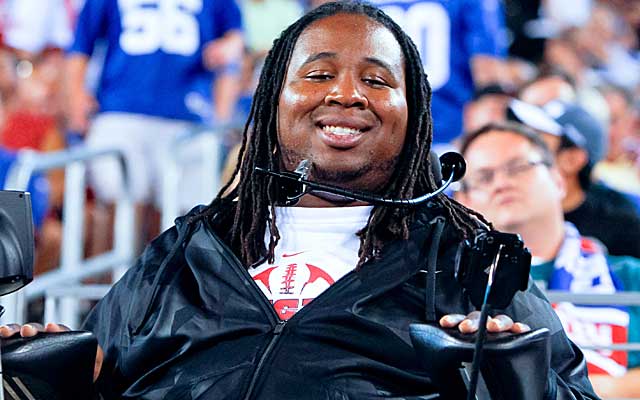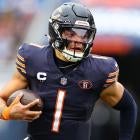 |
| Rutgers player Eric LeGrand was paralyzed covering a kickoff. (US Presswire) |
NEW YORK -- Roger Goodell was right last week, ahead of his time, a visionary. There was no agenda except player safety when the NFL commissioner suggested it might be time for his league’s competition committee to consider eliminating kickoffs.
Snickering could be heard from Who Dat Nation to Green Bay. There had to be an angle. 1) Goodell wants to keep his stars ambulatory; 2) Any such proactive stance limits the NFL’s liability.
Sure, fine, OK. Those goals should be lofty enough for any of us. We are reaching the tipping point in the player safety discussion. The same game that is so highly evolved it can produce a first-time freshman and second-youngest Heisman winner is at the same time working at this moment on a generation of bigger, faster, stronger defenders to hunt him down.
| To kick or not to kick |
| Analysis |
  |
| More college football |
You don’t want to be inside the mind of the average SEC defensive coordinator at the moment. Not after being embarrassed by Johnny Football’s arm and legs this season. If Johnny Manziel is going to repeat as a Heisman winner, first he has to survive as a football player. He knows it. His coaches know it.
“Since I am small in stature,” Manziel said Saturday in drawing inspiration from Doug Flutie, “it’s awesome.”
But the little man who succeeds like Flutie/Manziel faces longer odds than the 6-foot-6, 250-pound Cam Newton.
Football is at its core a game of action and reaction. Manziel is going to have a harder time succeeding the same way Devin Hester doesn’t score every time he fields a kick. The flying wedge was outlawed when too many players died. It was eventually deemed the leather helmet wasn’t enough protection.
It is now known that most concussions occur on special teams. Kevin Guskiewicz is a distinguished professor and chair of North Carolina’s Department of Exercise and Sport Science.
“Kickoffs and punts are considered to be more dangerous,” said Guskiewicz, who has consulted with both the NFL and NCAA, “simply because you typically have more players running full speed at one another from greater distances.
The NCAA rules committee has discussed the kickoff issue, although eliminating it has not become a formal talking point.
“Truthfully, it’s something you have to examine. It doesn’t mean that you do it,” said Air Force coach Troy Calhoun, chairman of the committee.
Following the NFL’s lead on tweaking kickoffs in 2011, the NCAA moved touchbacks out to the 25-yard line this past season. Kickoffs started at the 35, instead of the 30. Players were allowed no more than a five-yard run up. Halfway through the season there were more touchbacks than in all of 2011.
“If you ask most defensive coaches, ‘I don’t have to cover a kickoff. The ball is going to start at the 25. I’ll live with that,’ Calhoun said. “Ask most offensive coaches, they’d say the same thing.”
Think of the end of kickoffs as more evolutionary than rule change. We are reaching critical mass on negative reinforcement reducing catastrophic injuries -- suspensions, fines, etc. If you take part of the game away, you’ve taken the increased possibility of injury away. Since the NFL adjusted its kickoffs in 2011, there has been a 42 percent reduction in concussions according to Guskiewicz. I’ve said many times that the player safety issue is in direct correlation to how many debilitating injuries we can tolerate.
There’s a number out there somewhere before enough paralyzing hits are enough. One concussion, one death too many. Because that’s next -- someone/some people dying. You know it as well as Goodell and the NCAA. And the deaths won’t stop at one. Advances in equipment technology cannot possibly keep up with bigger, stronger, faster.
“Improved helmet design or added padding alone with not solve the concussion problem …” Guskiewicz said. “We need to place more emphasis on behavior modification and improved tackling techniques.”
Goodell’s league already faces a massive legal battle from the scarred veterans of the past. It’s only a matter of time before the NCAA faces a courtroom over its ability to protect its players.
As soon as that happens, commissioners, presidents, owners and athletic directors will find it a lot easier to eliminate kickoffs. But why wait? Cut to the end game. Eliminating kickoffs lessens risk and, eventually, saves limbs and lives.
It seems almost silly now that each game begins with a faux recreation of Braveheart with warriors clashing head-to-head -- sometimes, literally -- on the field of battle. The battle gear is there, all they’re missing is swords and axes.
What romanticized version of manly men football are we holding onto? At the moment, it’s a case of the aesthetic trumping the sensible. The shaky argument: Kickoffs are part of the fabric of the game. So are knee dislocations and separated shoulders.
Unofficial research -- mine -- shows there are many more Eric LeGrands in our future. LeGrand was the former Rutgers player who was paralyzed covering a kick two years ago. His coach Greg Schiano, now with Tampa Bay, came up with the radical idea of outlawing kickoffs. The team possessing the ball after a score would have the option of going for it on a fourth-and-15 play -- the equivalent of an onside kick -- or punting from the 30.
Why not do this yesterday, because of some silly notion of how the game would look? You don’t dismiss a mere discussion because it seems strange. Pitchers used to bat until American League officials chose to bastardize their version of the game with the DH. That’s strange.
I’ve seen NFL players complain about peers losing jobs. What I interpret that to mean: NFL players trying to defend their macho ethic. This sort of rule change doesn’t put Hester out of a job. It keeps him and his teammates upright enough to earn more money. Oh, it might add a little excitement to a largely mundane exercise. Can you imagine the Mike Leaches among us, going for it on fourth-and-15?
Anything that falls short of embracing this discussion, is delaying or denying. The NFL fines, suspends, ejects. There is a small “strike zone” on a quarterback’s body where he can be legally hit. NCAA game officials are particularly sensitive to anything close to a head shot. All good initiatives. There has to be more.
Eliminating kickoffs is the next logical step. The NCAA rules committee will meet in February. A two-year cycle can be ignored and rules changes implemented immediately if they have to do with player safety. So where’s the controversy when Goodell floated the idea last week?
Banning kickoffs should be non-negotiable. They’re dangerous. Our DNA tells us that if some activity causes pain, we tend not to repeat that activity. Like waving your hand over a flame or watching Rachel Ray.
Banning kickoffs is non-negotiable -- and may not occur for years. If all Goodell was doing was laying the groundwork for the fundamental change in his league’s rules last week, it would be the most righteous tackle (of an issue) in history.




















